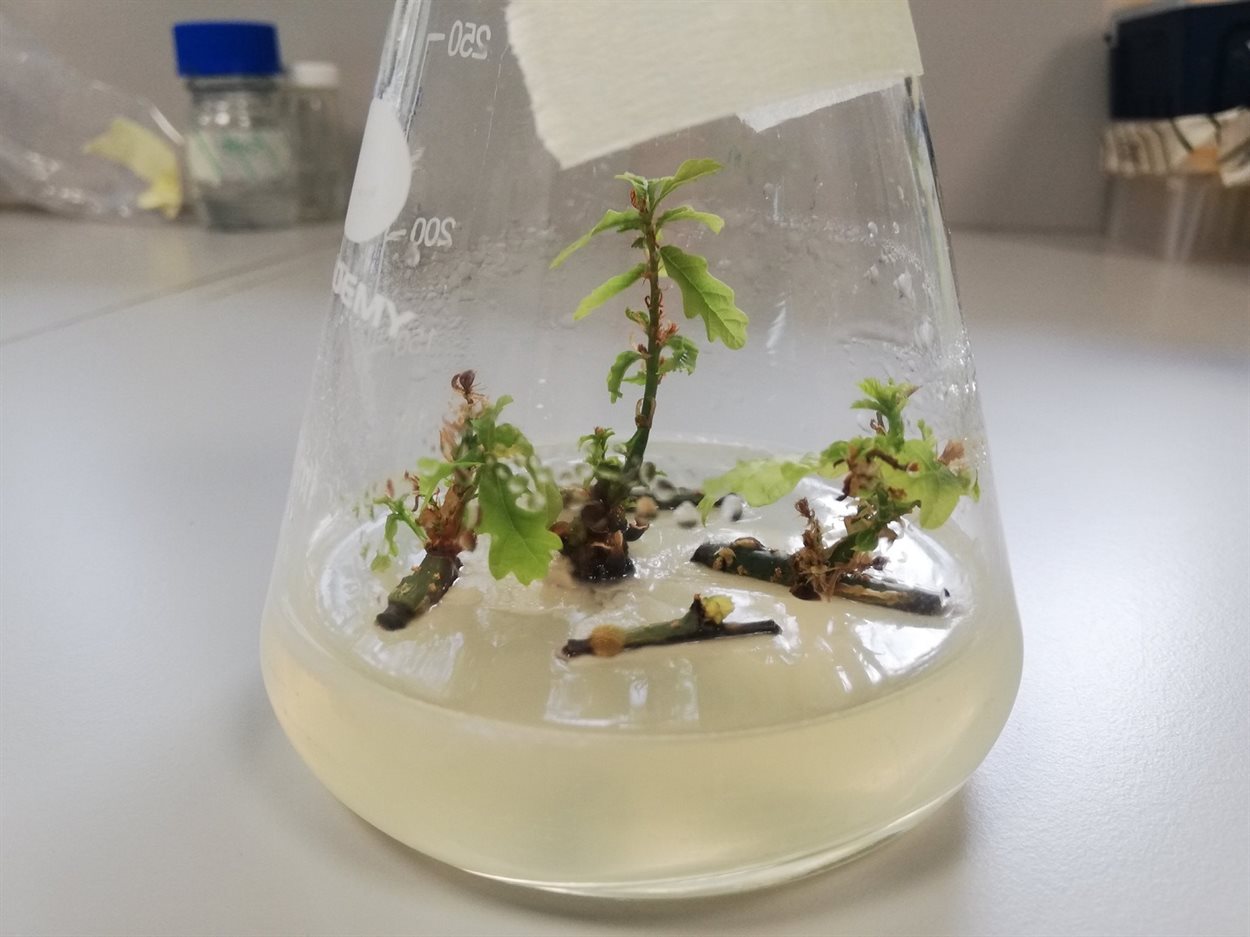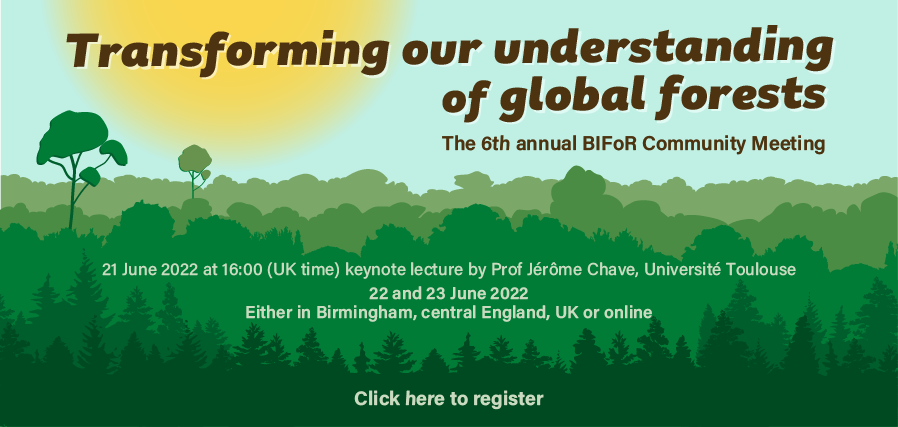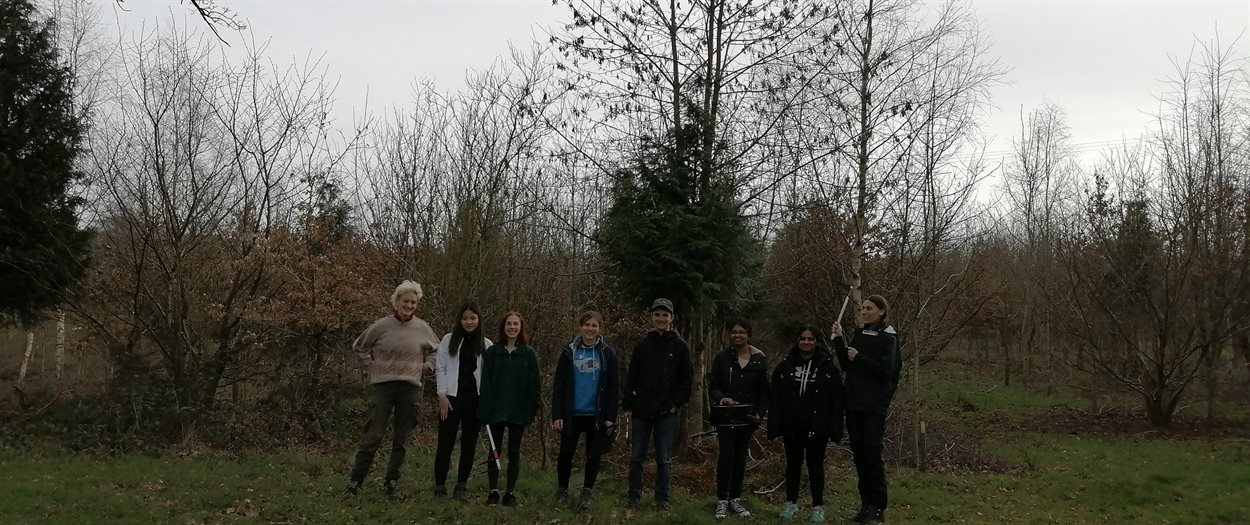
Image caption: New oak plantlets, created from leaf and stem cuttings, grown in special media, light and temperature combinations over several months in sterile conditions. Creating genetically identical seedlings allows researchers to better understand the genetic components of oak disease resistance. Dr Graeme Kettles & Dr Andrew Plackett. Image credit Dr Graeme Kettles
Trees for the Future
The latter end of 2021 was extremely busy for BIFoR with COP26, the ‘Trees for the Future’ conference and the release of our first scientific paper, led by Anna Gardner, from research at the BIFoR Free-Air Carbon Dioxide Enrichment (FACE) facility. We’re all set for the 2022 growing season at BIFoR FACE and in April for the sixth growing season patches of mature woodland will be experiencing the atmosphere of the future! Prof. Alice Roberts visited the FACE facility recently and recorded some interviews with our postgraduate researchers, the videos are on YouTube. A virtual tour of the BIFoR FACE facility will take place on 18 May 2022 between 10:00 and 11:00 (free of charge, via Zoom, registration required)
At COP26 the sustainable management and conservation of the world’s forests was hotly debated. Headline news saw 137 countries commit to end forest loss and land degradation by 2030 and $19.2 billion pledged to protect & restore forests globally. BIFoR colleagues attended COP26 closed sessions, while a BIFoR science and art display in the Green Zone showcased our research to the public. Also at COP26 the exciting news of funding for a third FACE experiment in a mature forest was announced formally — Amazon FACE. We’re already planning how we can combine data from all the forest FACE facilities including EucFACE in Australia.
The first results of our FACE facility show the whole forest system in a mature temperate forest responds promptly to elevated CO2, effects cascading through the ecosystem patch via carbon, water, and nutrient-cycles. Whether these signals will persist and will be replicated in different forest types such as the tropical forest of the Amazon is, literally, the $50M question for BIFoR FACE and the trillion-dollar question for us all.
Incorporate tree species diversity in reforestation, to maximise climate mitigation. This key message emerged from the AAB /BIFoR Trees for the Future conference. Prof Christine Foyer’s report concludes that “it should certainly be possible to design a plantation that will blossom into a forest for future generations. There are paradigms for such approaches. Learning from them is essential if we are to use planting forests as a practical, dependable and just response to our climate and biodiversity crises.” Read the full report online. The recommendations from the conference are summarised in a White Paper "Forest Innovation to tackle the Climate and Biodiversity Emergencies."
Further to the AAB /BIFoR Trees for the Future conference a new 'Applied Tree and Forest Biology Special Interest Group' has been set up. Further details are on the AAB website.

Funding Success
Dr Florian Busch achieved a perfect 10 score for a new research NERC standard grant project (£870,000) that will use cutting-edge technology and mathematical modelling to advance our understanding of plant carbon uptake. Dr Busch will make use of the BIFoR FACE facility to determine how much CO2-diffusion processes inside the leaf limit photosynthesis in trees, both under current and future environments. The project addresses a major uncertainty in carbon cycle modelling, which currently does not include this process.
The research will initially investigate the basic mechanism of CO2-diffusion inside the leaf using plants grown at the Wolfson Advanced Glasshouses to measure instantaneous changes in CO2 diffusion in response to environmental stimuli, before testing the capacity of forest trees to acclimate to higher CO2 concentrations in a natural environment.
Dr Adriane Esquivel Muelbert was awarded a Royal Society Research Grant (£20K) for work in the Amazon investigating large Amazonian trees.
Enthusing the next generation
 In March nineteen volunteer undergraduate students helped us measure over 3,300 trees as part of a Woodland Diversification study on an estate in Staffordshire (image above). Many more opportunities are arising to volunteer with BIFoR thanks to the 48 PhD students now in place and looking for help and to provide some mentoring.
In March nineteen volunteer undergraduate students helped us measure over 3,300 trees as part of a Woodland Diversification study on an estate in Staffordshire (image above). Many more opportunities are arising to volunteer with BIFoR thanks to the 48 PhD students now in place and looking for help and to provide some mentoring.
During February half term, families were invited to The Exchange, Birmingham City Centre, to join a series of workshops about the ‘Secret Life of Trees.’ More than 400 visitors attended. Each day there were different interactive activities for example looking close up at tree rings and a plant detective challenge focussing on tree disease and pests. The interactive activities were led by BIFoR, Birmingham Tree People and the Royal Forestry Society. A few VIPs dropped by too including Birmingham Mayor, Andy Street, and Chief Medical Officer, Prof. Chris Whitty. The 'Air We Breathe' exhbition featuring BIFoR FACE research will be open until June 2022.
MEMBRA - Understanding Memory of UK Treescapes for Better Resilience and Adaptation
We know that trees retain a record of history – but do they have memory? MEMBRA research will advance the concept of memories of stress in trees. The imprinting of memory in plants mostly happens by altering its epigenetic signature: i.e., changes that occur to the DNA that alter the activity of some genes, but that do not involve changes of the DNA sequence itself. MEMBRA will provide the tools to identify the species and populations that will result in better resilience and adaptation and that will therefore be used in conservation and planting strategies. The project will include creative outputs from ‘Walking Forest’ - a ten-year artwork taking place in sites across the UK exploring the links between activism, forest ecology and community.
Research highlights:
Realistic Forests and the Modeling of Forest-Atmosphere Exchange In forests there is an especially intricate set of exchanges with the atmosphere, where microbes and animals add to the quantity and variety of exchanges. Forests' patchwork structures mean that trees may experience profoundly different climates to others only meters away. This paper reviews recent developments in the understanding of exchanges between the air and realistic, patchy forests. Bannister, E.J., MacKenzie, A.R., and Cai, X.M (2022) https://doi.org/10.1029/2021RG000746
‘Can't see the forest for the trees’: The importance of fungi in the context of UK tree planting Tree planting now forms a major part of the UK climate mitigation strategy. This paper presents four key reasons why fungi should be considered in tree planting strategies.
Baird, A. and Pope F. (2022) https://doi.org/10.1002/fes3.371
Welcome
We welcome Dr Shoaib Amjad (visiting Assistant Professor from Women University AJ&K Bagh, Pakistan); Dr Johanna Pihlblad (postdoctoral researcher joining the FACE underground project); Dr Yafei Gao (postdoctoral research joining the DiRTS project); Bruno Cintra and Rodrigo Bergamin (Research Associates joining the UKRI Treescapes/MEMBRA project) William Hagan Brown (PhD on forest canopy temperatures).
Congratulations
We congratulate: Dr Josep Barba Ferrer who has now moved to CREAF, Spain; Aileen Baird who has taken up a position with Natural England as their Lead Advisor on the Tree Action Plan. Graduands: Dr Alfred Bockari (Air pollution emissions from charcoal production); Eszter Toth (Can forests balance the brain?).

Image caption: The expanding Tree Pathology team held an away day to brainstorm approaches for tackling fungal and bacterial diseases.